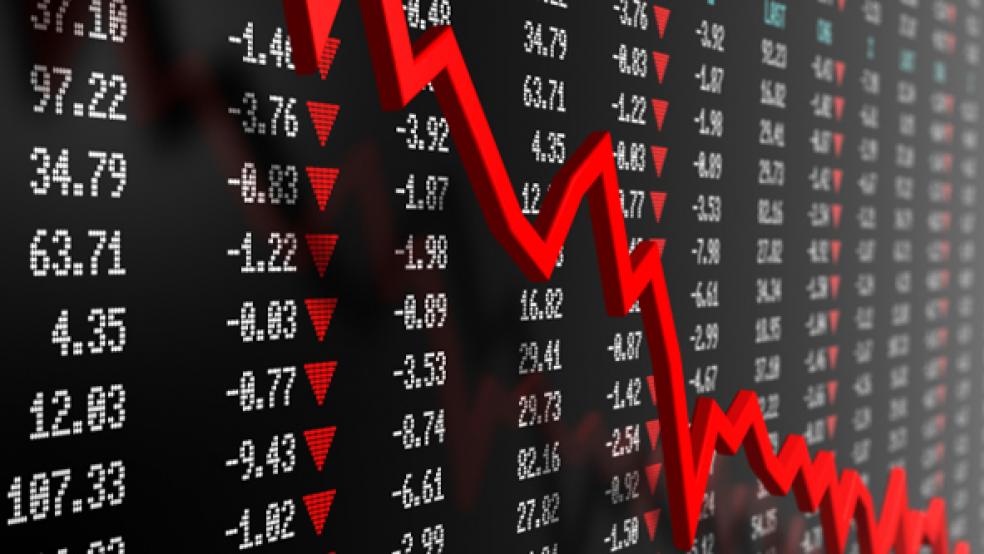Monday's sudden dive in oil prices appears more and more unusual with hindsight, and poses questions for traders, regulators and exchanges alike about just who or what caused such a major turnaround in the market.

Explanations range from a "fat finger" trading error or a high-frequency computer trading program run amok to a concentration of stop-loss orders being triggered or a single large trade by a hedge fund selling up to 10 million barrels of crude in a single clip, though no one appears to know for certain. The veil of secrecy surrounding derivatives trading also makes it hard to reconstruct the sequence of events that led to the plunge in Brent futures shortly before 2 p.m. EDT (18:00 GMT).
Only market regulators and the exchanges themselves have access to the detailed trading data, including the identities of buyers and sellers, that would make it possible to describe the chain of events in full.
RELATED: SEC Cracks Down to Prevent Another Flash Crash
In recent years, the only sudden move that has been properly explained was the flash crash in U.S. equity markets on May 6, 2010. And that was only possible because the Securities and Exchange Commission (SEC) and Commodity Futures Trading Commission (CFTC) set up a detailed enquiry that took more than four months to publish its conclusions. ("Findings regarding the market events of May 6, 2010: Report of the staffs of the CFTC and the SEC to the Joint Advisory Committee on Emerging Regulatory Issues," Sep 30, 2010.)
CURIOUSER AND CURIOUSER
The CFTC is looking into Monday's oil price drop and is collaborating with Britain's Financial Services Authority (FSA) which regulates the London-based Brent market.
CME Group, which operates one of the two principal oil markets, has described the drop as a "coordinated selloff" not caused by any technical failures. Intercontinental Exchange (ICE), which runs the main Brent contract, has declined to comment on whether it saw any unusually big orders placed during the period. It did, however, say: "Following rumors regarding the Strategic Petroleum Reserve (SPR), volume was widely distributed and oil prices declined over a period of time. Circuit breakers were not triggered and markets were orderly."
In the absence of a study like the one into equity prices in 2010, the trigger for the drop in oil prices may never be known with any certainty.
That should concern oil market participants because the September 17 price drop had characteristics of both a flash crash and a more significant and long-lived turning point. Trading that day was far from normal. Charts 1 and 2 show trading activity on the day and two days later on Wednesday September 19, another day on which prices fell heavily. The vertical scales are identical to make comparisons easier. The total price range on both days was similar: $5.52 on the Monday and $5.58 on the Wednesday. But in other respects the trading action could not have been more different.
On Monday, the plunge in prices and surge in trading volume was concentrated in 20 minutes between 17:50 and 18:10 GMT, with an extraordinary 10,000 contracts traded in the space of 60 seconds at 17:55 GMT. On Wednesday, by contrast, prices slid steadily throughout most of the day, with volume never exceeding 5,000 contracts a minute, and no obvious discontinuity in pricing.
Although something unusual clearly occurred just before 18:00 GMT on September 17, such aberrations may be becoming more frequent as computer-driven trading accounts for a rising share of turnover and market-making. It is tempting to write off the events of September 17 as merely a flash crash. But they also appear to have coincided with, and perhaps caused, a much bigger turning point in the oil markets. After rising steadily by almost $25.70 per barrel or 28 percent from June 28 ($91.35) to September 17 ($117.02), the ICE November Brent futures contract has fallen $9.75 (8.4 percent) in the space of three days, in what appears to be a decisive turning point.
ANATOMY OF A FLASH CRASH
In their report on the 2010 equity market crash, the SEC and CFTC staff found that "against a backdrop of unusually high volatility and thinning liquidity, a large fundamental trader (a mutual fund complex) initiated a sell program to sell a total of 75,000 E-mini contracts (valued at approximately $4.1 billion) as a hedge to an existing equity position".
"This large fundamental trader chose to execute this sell program via an automated execution algorithm ("Sell Algorithm") that was programmed to feed orders into the June 2010 E-Mini market to target an execution rate set to 9% of the trading volume calculated over the previous minute, but without regard to price or time," the report noted. "On May 6, when markets were already under stress, the Sell Algorithm chosen by the large trader to only target trading volume, and neither price nor time, executed the sell program extremely rapidly in just 20 minutes."
The fundamental trader's sales were initially absorbed by high-frequency traders (HFTs) and other intermediaries causing a sharp rise in volume. But that fooled the sell algorithm into thinking there was more liquidity than was really the case, causing it to step up the pace of sales even further. In effect, the large fundamental trader sold faster than the HFTs and other intermediaries could find other long-term fundamental buyers, and ended up trading against itself.
"The Sell Algorithm used by the large trader responded to the increased volume by increasing the rate at which it was feeding the orders into the market, even though orders that it already sent to the market were arguably not yet fully absorbed by fundamental buyers or cross-market arbitrageurs," according to the report. The SEC/CFTC study highlights the interactions between liquidity, market fragmentation, a single large bungled trade, and the responses of HFTs and other market makers.
ACCIDENT OR DESIGN?
This week's fall in oil prices looks similar, and comes amid a period of high tension in the crude market. By September 11, hedge funds and other money managers, betting prices would rise further, had amassed a near-record long position in WTI and Brent-linked futures and options equivalent to 410 million barrels of crude, according to position data published by the CFTC and ICE.
At the same time, the White House has been hinting it might order a release of emergency oil stocks from the SPR to cap prices and prevent rising fuel costs harming the economy. And on September 18, the day after the flash crash, a Saudi official said Riyadh wanted prices to come down and was "working to bring it down."
From the published data, it remains unclear whether September 17's price drop was an accident, or if someone decided to give the market a good hard shove, putting on a large position in a short space of time with the intention of moving the price.
Whatever the cause, it has triggered a cycle of liquidation that has pushed prices much lower. That will be welcome in the White House, but for hedge funds and other investors who had amassed a big long position on the expectation of further rises it is exceptionally painful. For both sides of the market it raises unsettling questions about just what happened on Monday that could produce such a big turnaround in the whole direction of the market.
(John Kemp is a Reuters market analyst. The views expressed are his own)




